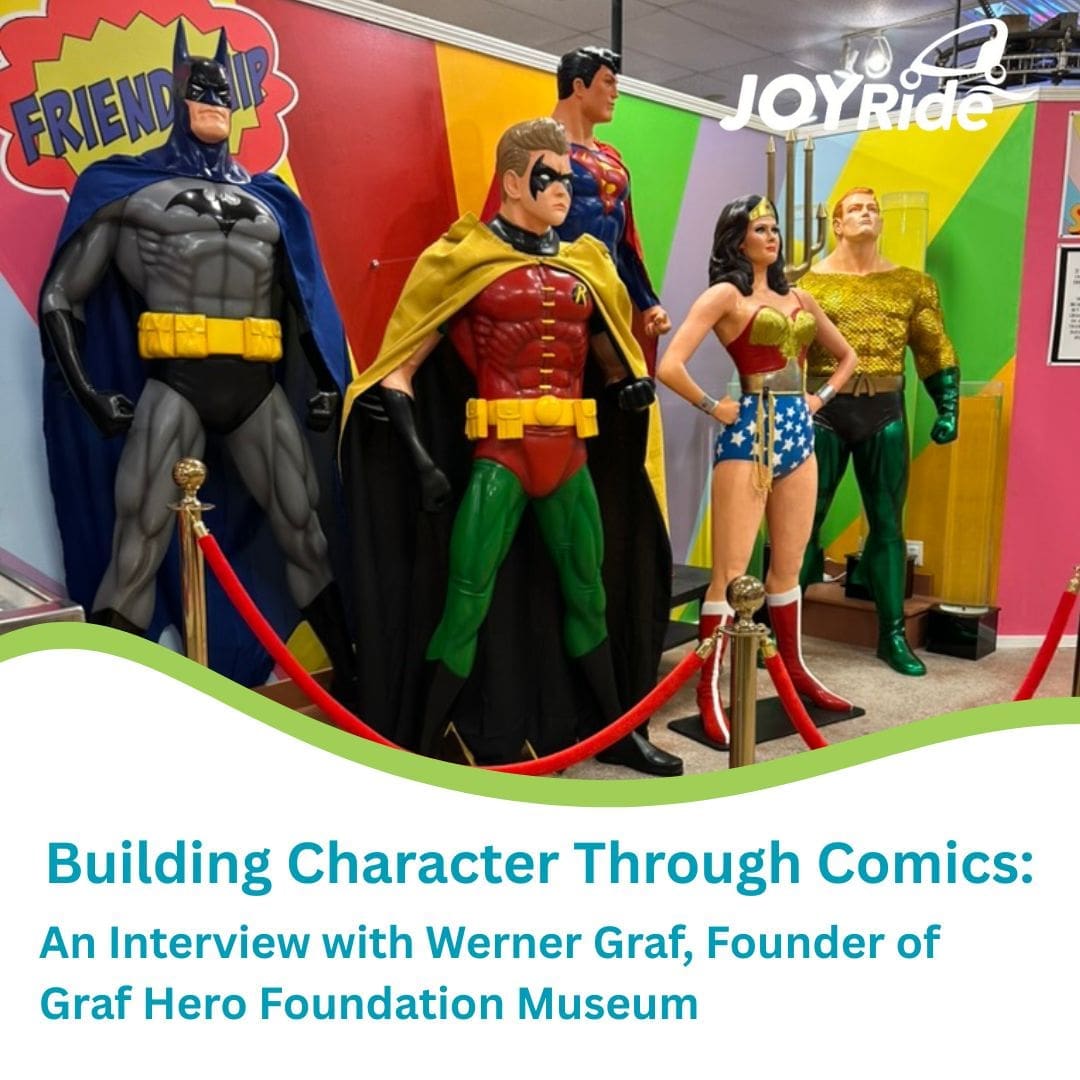The Graf Hero Foundation recently opened a unique superhero museum and character-building experience at Michigan City’s Lighthouse Place Premium Outlets. We sat down with Werner Graf, the founder, to discuss the vision behind this remarkable collection and its mission to inspire young people through the positive messages found in comic book heroes.
Tell us about the concept behind the Graf Hero Foundation. What inspired you to create this unique museum?
“The foundation is all about building character in young kids, and we’re using superhero collectibles as a hook. When I was growing up, the things that impacted my worldview were what I read. There’s an old adage that you’re a product of the people you meet and the books you read. When I was nine or ten years old, I was reading all these comic books, and they all had very positive messages built into the characters.
Some were very overt, like Spider-Man’s “with great power comes great responsibility.” As a kid, if you like Spider-Man, you realize that when you have the power to do something good, you ought to do it. The Fantastic Four was all about family, and the Hulk was about controlling your anger. All these different themes were built in, and you absorbed them by osmosis.
How do you weave these character-building messages into the museum experience?
“Take a look at our Hulk wall over there, featuring the posters. We’ve slotted in a Ben Franklin quote about anger because he was always trying to control his temper. When kids come through on field trips, and we offer free field trips to all elementary schools, we get a half hour to talk with them about history and character building before they enjoy the museum, art gallery, and pinball machines.
We’re going to have QR codes everywhere. On the Hulk exhibits, each poster will tell the story but also talk about controlling your anger. When kids come in and see Captain America, they’ll scan the QR code and learn about how he was created by Joe Simon and Jack Kirby in 1940, but they’ll also learn about John Hart, one of the signers of the Declaration of Independence from Hopewell, New Jersey, who gave up everything for his beliefs”
You have some interesting pieces of local history. Can you share an example?
“That Declaration of Independence display with Captain America came from Philadelphia City Hall. It was a gift to the City of Philadelphia for their bicentennial anniversary. When they renovated in 1992, they didn’t have a place for it and sold it at auction. So we bought it, and now Captain America introduces the Declaration of Independence.
We even have the great-great-great-great-grandson of John Hart, who still lives in Hopewell, New Jersey, making an audio/video presentation for us in the church that John Hart used to attend. He’s going to talk about how his ancestor gave up everything because of his perseverance and courage – the themes that frame our Captain America exhibit.”
What’s your connection to Michigan City?
My grandfather came over from Germany in 1928 and started the Graf Dairy on Michigan Boulevard back in 1932. It ran for about 18-20 years before consolidating with other local dairies. When refrigeration and wax milk cartons made grocery store milk more convenient than delivery, all the dairy businesses consolidated in the late 1940s.”
How did you end up in this space at the Lighthouse Premium Outlets?
Originally, I had planned to put the collection in the old Franklin Bar and Grill building that I bought, but it turned out to be a borderline demolition; the roof had fallen in. While I’m still working on that project, I needed a temporary home for the collection.
I had met with the Lubeznik Center staff to learn about displaying artifacts, and director Janet Bloch suggested we be their summer exhibit. It was one of their more popular shows. After that four-month run, Chief Corley of the Police Department, who had relationships here at the mall, connected us. This 7,000-square-foot space is actually superior to what we were originally looking at, and we benefit from mall traffic.”
What makes this collection special?
“This isn’t just toys you could buy; there’s a lot of point-of-sale promotional material that you couldn’t purchase. Like these posters were hanging in 7-Eleven windows in 1974, advertising Slurpee cups. As a 10-year-old, you had to beg the manager to give it to you when they were done. There was no price tag because it wasn’t for sale.
If you’re a collector and you see that unopened Parker Brothers Spider-Man Atari game, that could go for $10,000. It was the first Marvel hero ever in a digital game. But kids enjoy the pinball machines, and nostalgia buffs recognize things they had growing up.”
Beyond the museum, what other programs do you offer?
“We’re all volunteer-run, so local high school students can check off their service boxes since we’re a 501c3. They learn people skills, how to deal with customers, manage a POS system, and deposit money at the bank.
We’re setting up an art room with a donated $17,000 Promethean board, a 72-inch computer screen where 15 kids can annotate art simultaneously and email their creations to themselves. We’ll tie in with school art departments and offer seminars and classes.”
What’s your vision for the space as a community gathering place?
When I was 14, we had Marquette Mall, where you could just hang out safely. We had roller skating rinks and robust movie theaters. All those gathering places have disintegrated over time.
After we get the word out, we’re hoping this becomes a safe, fun gathering spot for kids. Everything’s behind glass, and we’ll have tables where they can hang out. For $10, kids get unlimited pinball games.”
How can the community support the museum?
“Visit us! We’re at Lighthouse Place Premium Outlets, open during mall hours. Bring your kids, bring your grandparents. There’s something for everyone. We offer free field trips to schools and are building partnerships throughout the community.
Remember, this is a foundation, so everything goes back to the community. When we start generating revenue from visitors, we can fund programs and continue expanding our character-building initiatives.”
Any final thoughts?
This collection represents decades of careful acquisition. I bought my first comic book when I was nine years old, and I never opened most of these items, which is why they’ve appreciated in value. However, more than their monetary worth, these pieces represent positive messages and values that have shaped generations.
If we can use superhero stories to teach kids about courage, responsibility, controlling anger, and the importance of family, while also teaching them real American history through figures like John Hart, then we’ve accomplished something meaningful. We’re not just preserving pop culture; we’re preserving the values that built our community.”
We want to thank Werner Graf for taking the time to share the new Graf Hero Foundation Museum with us. The museum is located at Lighthouse Place Premium Outlets in Michigan City. For more information about visiting, field trips, or volunteer opportunities, contact the foundation through their website or visit during regular mall hours.






